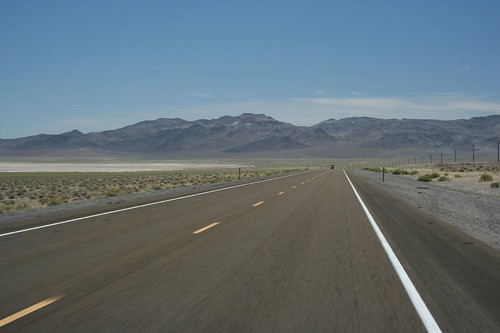I guess one side effect of there being so much national attention on Western Nevada, because of the Steve Fossett story, is that people are realizing we’re not joking when we say Nevada is nothing but a barren desert. This story hit the Associated Press yesterday, and is being printed is papers and websites all over the country. And even though the writer is based in Reno, he manages to sound truly and honestly awed at how desolate the Nevada desert is.
Superimposed over a U.S. map, Nevada’s 110,000 square miles would stretch from New York City, west to Pittsburgh and south to Myrtle Beach, S.C. Then remove nearly all the people.
While Nevada’s population has been the fastest growing in the nation for most of the last three decades, it averaged just 18 people per square mile in 2000, according to the U.S. Census Bureau.
Even that doesn’t tell the whole story. Some 2.3 million of Nevada’s nearly 2.6 million residents live in just the two counties that include Las Vegas and Reno. Across the rest of Nevada, there are fewer than three people per square mile.
The severe landscape that marks the overwhelming majority of Nevada is far different from the traditional travel brochures that feature the beaming lights of the Las Vegas strip or the forested ski resorts ringing Lake Tahoe.
Miles of high desert are broken up by hundreds of mostly barren, craggy mountain ranges rising 8,000 to 11,000 feet from dry lake beds and seas of sagebrush. The state has 300 named mountain ranges – more than any other state in the nation – and few roads outside its main cities and towns.
The article ends with a quote from a resident who has had to endure the drive from Reno to Las Vegas, and perfectly captures the essence of the trip.
“Boring. Just so monotonous,” Sullivan said. “It’s just dirt, sand and a couple three or four small towns you’ve got to drive through.”
Which provides a nice segue to my Road To Vegas series of articles, and to let you know that although I’ve been neglecting the series for over a month, I should have another new installment ready soon. Because I choose to show you, not just tell you, how desolate Nevada is, and to bring you snapshots of those “couple three or four small towns.”



Among other definitions of desolate are bare, providing no shelter or sustenance, deserted or uninhabited, barren or lifeless, devoid of inhabitants, deserted, isolated, uninhabited, and wild.
There are certainly great expanses of Nevada which can be described as desolate, but the Great Basin as a whole cannot be described as desolate. For every bare area, there is a corresponding richly vegetated area and for every area devoid of shelter or sustenance, there are innumerable areas supportive of life. Other than restricted areas of Southern Nevada, communities of varying sizes and services exist within 100 miles of each other throughout Nevada. There is a rich and complex ecosystem existent in the Great Basin which fulfilled the needs of the hunter-gatherers for thousands of years.
As the population of our booming state continues to swell, those with any kind of aesthetic sensibility regarding the Great Basin and its many attributes will mourn the loss of its “desolation” and yearn for a return to its bare, providing no shelter or sustenance, deserted, uninhabited, barren, lifeless, devoid of inhabitants, deserted, isolated, uninhabited, and wild state.
Paraphrasing “The American President” here: “Nevada is hard work.” The Bride was talking about moving from California’s central valley to Gerlach (desolate!) in the 1970s and how much she hated the nothingness. Now she wouldn’t go back to CA if you paid her.